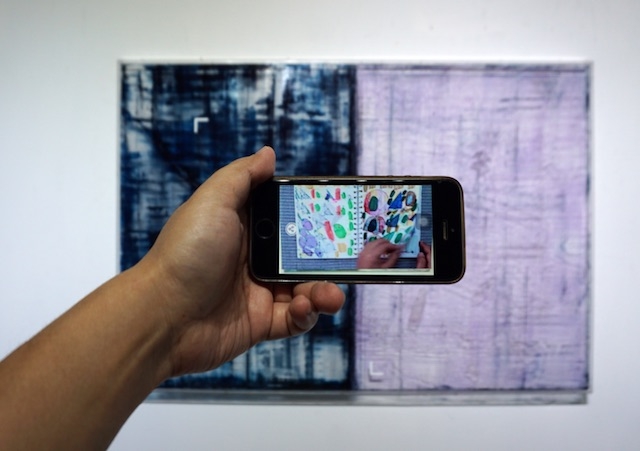At the heart of Indonesian artist Aditya Novali’s new abstract paintings for Significant Other is a clever technological intervention: an app called Artivive that plays an augmented-reality video and reveals scores of his sister’s childlike drawings, interrupting our encounter with Aditya’s artwork like a game of peekaboo. Aditya’s sister, Ade, is a thirty-one-year-old with the mental age of a five-year-old. Their parallel expressionism here interacts only through the app, which has to be downloaded and positioned in front of the painting in order to view Ade’s drawings, becoming a metaphor for the frustration and pressures of coexistence and the levels of disconnect experienced with mental disability.
There are two groups of works. The first, the ten abstract paintings with the embedded app, demonstrate Aditya’s dense, forceful brushwork that contains an underlying horizontal, sometimes gridlike leaning. His strokes allow hues to condense and amass as a hovering mirage, providing an illusion of depth that is further augmented by shadows within the paint. The second group comprises three works arranged in groupings, each a 10- or 11-piece installation of Aditya’s monochromatic geometrical shapes created with Plexiglas, over which images of Ade’s colourful drawings slide through in continuous projection.
The term ‘significant other’, as the exhibition text notes, carries parallel definitions: more commonly, ‘partner’ or ‘loved one’ as well as the psychological definition of someone bearing great influence or importance to another in formation of self-concept or identity. Parallelism between brother and sister thus unearths uncanny points of contact and mutual influence, a relationship more symbiotic than Aditya, as the catalogue attests, realised. However, the relationship also shows up uncomfortable, stark differences.
Ade’s influence on Aditya is traceable in his choice of colour fields for this series of paintings, particularly red, purple and green, colours Ade abundantly employs in her drawings. Many of the works reveal Aditya’s usual deployment of mathematical logic and gridlines underneath the paint layers, striking a similar chord to Ade’s obsessive row upon row of uniform shapes that connote but never coalesce into tree or house or fish. While Aditya’s mathematical lines are precise and technically sophisticated, Ade’s drawings, her colouring that often spills over the edges, reveal the mental age that she’s stuck at.
This disparity is most evident in the second group of works, (dis)connected geometry 1, 2 and 3 (all works 2018), where their stark stylistic differences but similar artistic inclinations towards geometric shapes are presented almost as one artwork; their works overlap but do not intertwine. The disconnect has an introspective aspect because it is Aditya’s geometric shapes that appear separate, unconnected and thoroughly logical, while the projection shows his sister’s drawings as a continuous run of indeterminate shapes, fluid in their vibrant washes.
Ade’s reluctance to submit her drawings to a wider audience spurred Aditya’s search for a technological solution and inspired this new series, which Aditya bills not as collaboration but as a ‘juxtaposition of works’. It is unclear how much agency Ade had in this project, and while the warp and woof of the sibling relationship as glimpsed through their art has its points of interest, occasionally her works come across as a decorative foil to her brother’s. A more robust treatment of her contributions – in terms of her process, for example – might make for more comfortable and illuminating viewing. In its current form, the exhibition raises a number of issues surrounding artistic partnership with a mentally disabled person in terms of capacity and consent.
Aditya Novali: Significant Other at Shanghart Singapore, 9 August – 21 November
From the Winter 2018 issue of ArtReview Asia
